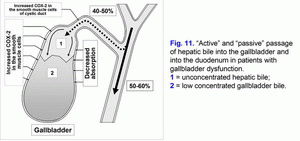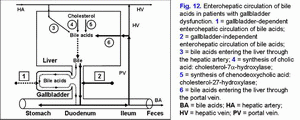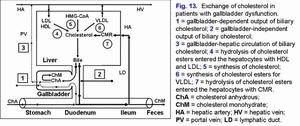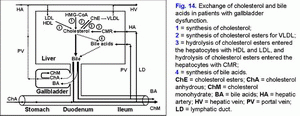
Русский | English
Gallbladder Dysfunction
|
|
The gallbladder dysfunction is a disorder of the gallbladder contraction which reveals as biliary pain (1). The cause of the gallbladder hypomotility can be an increased basal cystic duct resistance or cystic duct spasm, the muscle hypertrophy, or the chronic gallbladder diseases. Diagnostic criteria of the gallbladder dysfunction
Causes of the gallbladder evacuation dysfunction
Mechanism of development of pathologic disordersDecrease in the evacuation function of the gallbladder to less than 40% results in the decrease in the “active” and “passive” passage of the hepatic bile into the gallbladder and in the concentration of total bile acids in the gallbladder bile (fig. 11). The decrease of the “active” and “passive” passage of the hepatic bile into the gallbladder results in the increase of the passage of the hepatic bile into duodenum and of the gallbladder-independent enterohepatic circulation of bile acids, biliary cholesterol and biliary bilirubin (fig. 12). The increase of the gallbladder-independent enterohepatic circulation of bile acids causes increase in the concentration of bile acids in the hepatocytes and in the decrease of excretion function of the liver (i.e. formation of chronic “bland” intrahepatic cholestasis) (fig. 12). The increase of the gallbladder-independent enterohepatic circulation of biliary cholesterol causes increase in the absorption of the biliary cholesterol in the small intestine, the biliary cholesterol entering the hepatocytes and the high secretion into hepatic bile (fig. 13). These two factors cause the formation of the “lithogenic” hepatic bile. Decrease of the gallbladder-dependent output of biliary cholesterol and of the concentration of total bile acids in the gallbladder bile cause formation of the “lithogenic” gallbladder bile and precipitation of cholesterol monohydrate crystals in the gallbladder lumen on 10% of the patients with gallbladder dysfunction (fig. 14). Precipitation of cholesterol monohydrate crystals on the epithelial cells of the gallbladder causes increase in COX-2 activity in the epithelial cells of the gallbladder mucosa and transformation of the gallbladder dysfunction into chronic acalculous cholecystitis without biliary sludge.
Pathogenetic treatment of patients with gallbladder dysfunctionTreatment of gallbladder dysfunction (gallbladder hypomotility with biliary pain) and for prophylactics of the chronic acalculous cholecystitis includes:
Celebrex (Celecoxib) is a selective inhibitor of COX-2. Inhibiting COX-2 activity in the smooth muscle cells of the gallbladder wall and cystic duct results in the relief of the biliary pain within 3-5 days, restoration of the evacuation function of the gallbladder and the gallbladder-dependent output of biliary cholesterol, “active” passage of the hepatic bile into the gallbladder, and decrease in the gallbladder-independent enterohepatic circulation of bile acids, biliary cholesterol and biliary bilirubin. Ursofalk (ursodeoxycholic acid), is a hydrophilic hepatoprotective bile acid. It helps in dissolving the cholesterol monohydrate crystals in the gallbladder, decrease in lithogenicity of the gallbladder and hepatic bile, disappearance of the chronic “bland” intrahepatic cholestasis (i.e. results in the restoration of the excretion function of the liver). Effectiveness is 95%.
Attention!!! Information for patients: Before using this scheme of treatment please check the contraindications (below) and side effects of using pharmacological preparations of Celebrex (Celecoxib) and Ursofalk (ursodeoxycholic acid), and obtain your doctor’s permission. Contraindications for Celebrex (Celecoxib):
Contraindications for Ursofalk (ursodeoxycholic acid):
This web page does not bear any legal responsibility for the use of the proposed treatment schemes without consulting your doctor. References:
|
|
|



